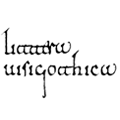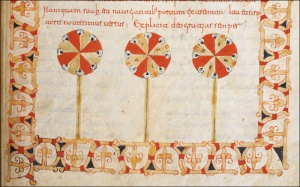ViGOTHIC: collaboration among scribes in the BL Beatus
Who copied the codex British Library Additional ms. 11695? Was it Dominico and Nuño as the codex says?
In my last ViGOTHIC/VisigothicPal update, I managed to synthesise the initial problems arisen after what was a first approach to the “the DigiPal software meets Visigothic script” theme. That is, the undeniable need to determine a new and specific terminology to describe Visigothic script itself, one usable by palaeographers in writing and for a computer in organising palaeographical “thoughts”, before going back to work on the case study BL Beatus. I also alluded to the other objective accomplished during the first four months of the project: to determine how many scribes intervened in the copy of the Apocalypse of St John of Patmos included in the codex British Library Additional ms. 11695; their graphic characteristics and differences. For those of you who are familiar with this copy of the Apocalypse, so-called Beatus (I wrote a post about it a year ago), for me to have set this objective might sound silly since it is well-known it was copied by two scribes, Dominico and Nuño. But, was it so? Surprisingly, and excitingly, it was not.
Methodology for palaeographical analysis

Example of the palaeographic analysis of one of the hands who intervened in the copy of the BL Beatus. Minuscule alphabet.
All palaeographers have a methodology to apply in order to not only describe a specific hand but have enough (palaeographic) arguments to further differentiate one scribe from another. That is, there is a list of things we focus our attention on, what makes what I was taught to call the fundamental elements of a script (their characteristics making those that define a specific hand). These elements are:
- Graphic quality (calligraphic to rudimentary) – some palaeographers prefer to distinguish between usual writing and calligraphic style, and indeed this differentiation should be taken into account for specific types of corpora (epistolae, inventories, catalogues, notes, etc.);
- Stroke speed (cursive versus minuscule);
- Angle of inclination, distinguishing between upright and leaning to the right or left;
- Contrast of the strokes (shading), expressed according to the subdivisions “pronounced”, “moderately pronounced” and “slightly pronounced”;
- Modulus – the proportions of the letters – expressed according to the subdivisions “flattened”, “rounded” and “slender”;
- Letter forms – all forms and their allographs;
- Ductus – the sequence and direction of the different strokes that make up each graphic sign;
- Ligatures and nexus, between letters and between words;
- Abbreviations (signs and forms);
- Punctuation (signs and forms);
- Text structure – aesthetic separation between each part of the diplomatic structure, proportion of the space left within the parchment for signatures, etc. – and variations in the course of the base line;
- Linguistic features (orthography and influences);
- Decoration, flourishes and other signs.
It might be that, in reading a publication on Palaeography, you will find that the author did not specifically added a bulleted list with all these aspects on studying, determining, and defining each hand, but you can be sure he or she had them in mind. And, this list is nothing new. In fact, it was more or less set around the 1960s (you can find bibliographic references about this on A. Castro Correa, “Palaeography, computer-aided palaeography and digital palaeography. Digital tools applied to the study of Visigothic script”, in Analysis of Ancient and Medieval Texts and Manuscripts: Digital Approaches, ed. by T. Andrews and C. Macé. Lectio: Studies in the Transmission of Texts & Ideas, volume 1. Turnhout: Brepols, 2014, pp. 247-272).
What happens then when we apply this methodology to the analysis of the 200 and so folios that make the BL Beatus exemplar?
ViGOTHIC: collaboration among scribes in the BL Beatus
Surprisingly, and although the first hand who works on the Beatus does a lot of work, he is not the only scribe we can find in there, individualised by a highly calligraphic minuscule Visigothic script. Nor was he helped in his task by just one scribe more, also using a very similar script.

Example of two – very similar – hands found in the BL Beatus. © British Library, Add. ms. 11695.
I am not going to unveil here how many scribes intervened in the copy of the Beatus – I do not want to spoil what will become a very nice article I plan to write –, just highlight that it was a collaborative task to copy the whole Apocalypse and add the illumination program. Rather, what I would like to share here is a reflection: bearing in mind that a hand evolves over time, how can we be sure that two – from our point of view different – hands are not the same? I mean, how many differences, or what graphic variations, are enough to allow us to state that we are dealing with two different scribes?

Example of what seems to be the same hand in different folios of the BL Beatus. © British Library, Add. ms. 11695.
It is not easy, moreover considering that the scribes working in the copy of the Beatus were doing so in a period of graphic change, from Visigothic script to Caroline minuscule, in the late 11th-early 12th century, and thus, many features of the Carolingian writing system were naturally added, over time, to each hand as a result of this graphic acculturation.
Relying on our experience, we eventually came to a conclusion, justified by graphic examples of all those variations and similarities. However, what I – and I guess every palaeographer – find more difficult is, once detected, to explain why they exist. Why can we find two hands which are almost identical but not the same? Where they master and pupil? Was one trying to imitate the other, and if so, why? To what degree was a scribe able to vary his/her hand still using the same script? How many different allographs or different ways to abbreviate the same word, or different punctuation signs, was a medieval/Visigothic script scribe able to recognise and use? How did they perceive these differences? It would have been very nice of them to let us know.
Within the group of scribes who copied the BL Beatus, I found one hand that is particularly helpful in discussing what should be considered a different hand or just the same hand’s natural evolution/variation, due to either graphic acculturation or to something else we will never know. You will find more about this hand/scribe soon in a guest post I am writing for the ‘Manuscript Collaboration Hub‘ blog.
by A. Castro
[update March 2016: Blog post ‘Spot the differences. Playing with medieval handwriting’ available here].
[edited 13/07/2018]

